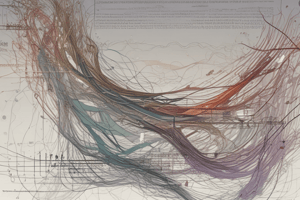Podcast
Questions and Answers
What is the main purpose of a defining clause in a sentence?
What is the main purpose of a defining clause in a sentence?
- To offer context about the noun
- To provide additional information
- To identify and distinguish the noun (correct)
- To introduce a side idea
Which of the following relative pronouns is commonly used to introduce a defining clause?
Which of the following relative pronouns is commonly used to introduce a defining clause?
- Why
- Whose (correct)
- When
- What
In a sentence, what function does a non-defining clause serve?
In a sentence, what function does a non-defining clause serve?
- To introduce the main idea
- To offer context for the verb
- To provide crucial details about the subject
- To provide additional information (correct)
Which of the following sentences contains a non-defining clause?
Which of the following sentences contains a non-defining clause?
Which relative pronoun is NOT typically used to introduce a non-defining clause?
Which relative pronoun is NOT typically used to introduce a non-defining clause?
In the sentence 'The book that I am reading is very interesting,' what type of clause is 'that I am reading'?
In the sentence 'The book that I am reading is very interesting,' what type of clause is 'that I am reading'?
Which relative pronoun is used for both people and things?
Which relative pronoun is used for both people and things?
Which type of clause provides additional, non-essential information about the subject?
Which type of clause provides additional, non-essential information about the subject?
In the sentence 'The dog, which barks loudly, scared the cat,' the phrase 'which barks loudly' is an example of a:
In the sentence 'The dog, which barks loudly, scared the cat,' the phrase 'which barks loudly' is an example of a:
What is the primary difference between defining and non-defining clauses?
What is the primary difference between defining and non-defining clauses?
Which of the following sentences contains a non-defining clause?
Which of the following sentences contains a non-defining clause?
In the sentence 'The boy, who won the competition, is my friend,' what type of clause is 'who won the competition'?
In the sentence 'The boy, who won the competition, is my friend,' what type of clause is 'who won the competition'?
Match the following sentences with the type of clause used:
Match the following sentences with the type of clause used:
Match the following descriptions with the correct type of clause:
Match the following descriptions with the correct type of clause:
Match the following sentences with the type of clause used:
Match the following sentences with the type of clause used:
Flashcards are hidden until you start studying
Study Notes
Clause Structure
A clause refers to a group of words containing a subject, verb, and object or complement. There are two types of clauses: independent clauses and dependent clauses. Each has its own function within a sentence and can stand alone if needed.
Defining Clause
A defining clause provides essential information about the noun it describes, making it a type of adjective. It identifies the noun and is often introduced by relative pronouns, such as "who," "which," "that," or "whose". Defining clauses are essential to understanding the subject and provide details that help distinguish it from other similar nouns in the sentence.
Example
"The woman who is wearing a red dress is my mother."
In this sentence, "who is wearing a red dress" is a defining clause that provides information about the woman by identifying her as the speaker's mother.
Non-defining Clause
A non-defining clause does not provide essential information about the noun it describes and is not necessary to understand the subject. It is a type of adverb and can be introduced by relative pronouns like "who," "which," "that," or "whose". Non-defining clauses describe the subject or provide additional information about it.
Example
"My mother, who is a doctor, is very intelligent."
In this sentence, "who is a doctor" is a non-defining clause that provides additional information about the mother but does not identify her.
Relative Pronouns in Clauses
Relative pronouns are used to introduce defining and non-defining clauses. They connect the relative clause to the noun it describes and show the relationship between the two. The most common relative pronouns are:
- Who: Used for people
- Which: Used for things
- That: Used for both people and things
Example
"The book that I am reading is very interesting."
In this sentence, "that I am reading" is a defining clause introduced by the relative pronoun "that."
In conclusion, clauses play a crucial role in constructing complete sentences, providing essential information about the subject and describing the relationships between nouns. Understanding the differences between defining and non-defining clauses and the appropriate use of relative pronouns is vital for effective communication and writing.
Studying That Suits You
Use AI to generate personalized quizzes and flashcards to suit your learning preferences.




